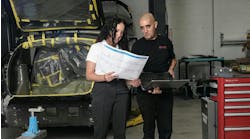Content brought to you by ABRN. To subscribe, click here.
What you will learn:
- How UV-cure primers can aid cycle time
- Why UV-cure primers have little to no waste
- How the application process differs
Automotive refinish centers across the country are on a perpetual mission to maximize profitability. In today’s highly competitive environment, the shops that find ways to work faster and more efficiently while minimizing waste will experience the highest levels of success – and help ensure their stability over the long haul.
An increasingly popular option that shops are using to streamline their paint operation and boost their bottom line is an ultraviolet (UV)-cured primer surfacer.
UV-curing is a photochemical process created when ultraviolet light is applied (typically with a handheld lamp) to coatings containing photoinitiators. These photoinitiators build chains of molecules that create the final layer of coating at incredibly fast speeds.
Initially introduced to the automotive industry in the early 2000s, UV primers were an unproven technology that required a new UV light to cure. This was a departure from the traditional infrared-curing lights shops used to help improve their efficiency. When you consider in the additional cost for the new UV-cure technology together with the safety precautions associated with exposure to UV light, it’s no surprise it took 20-plus years for the industry to embrace the use of UV products.
Benefits
One of the many advantages of a UV-curing primer surfacer is its ability to significantly reduce cycle time. Conventional primer surfacers can take up to an hour to cure in a bake cycle, yet UV-cured primers can be fully cured and ready to sand in as little as two minutes – ideal for completing small and medium size repair jobs. UV-curing primer surfacers can also be cured by direct sunlight in 10 to 30 minutes, depending on UV intensity.
Another key advantage of UV-cured primer surfacers is their cost savings. Beyond the technology’s ability to reduce the cost of labor by decreasing cycle time, UV-curing leaves little or no waste.
For example, a quart of spray-gun applied UV-cured primer can last three to four times longer than urethane primer due to its higher solids content. The benefit of a higher solids content, along with the 100-percent-complete curing that a UV product delivers, means there’s no shrinkage or repair mapping.
It’s also important to note that because UV products will not cure until exposed to UV light, UV-cured primers are not subject to pot life issues. Plus, most UV-cured primers are ready to spray, with no mixing or reducing required. This virtually eliminates waste, as any product left in a spray gun can be poured back into the original container. Incidentally, whenever a UV primer is poured out of its original container, it should be dispensed into a black or opaque spray cup to prevent UV light from curing it before it is sprayed.
Application
While applying a UV-cured primer surfacer will vary from one manufacturer to the next, there’s a general process. Painters start by spraying the product on the area to be repaired in thin layers. Next, using a handheld UV LED lamp, the painter directs the light onto the area at a distance of 6" to 8" from the panel surface for two to three minutes. The size of the repair will dictate the amount of time the light should remain on the spot, but most medium size repairs or smaller should be ready to sand or polish in no more than two minutes. No heat is involved, which enables shops to perform repair work on a variety of substrates, including steel, aluminum, fiberglass, and plastic.
Of course, like any technology, UV-cured primer surfacers come with a few challenges. For one, if sunlight reaches the area of repair while it’s being coated, the primer could begin to harden too soon and create issues with the finish. A more common failure can occur if the painter does not apply the UV light for the necessary length of time. This could prevent the finish from curing and result in adhesion issues.
The important thing to remember is that UV-curing technology is fairly simple. With some basic training and a bit of practice, a painter should be able to master the technique in no time at all.
An expanding marketplace
Many of the major brands in the automotive refinish space now offer a UV-cured primer. Some are newer to the market, while others have a well-established foothold. For example, PPG's OneChoice UV-Cured Primer Surfacer provides high-build performance in a maximum of two coats and exceptional UV-cured dry times. This new UV-cure offering is ideal for shops employing the rapid repair process.
The future looks bright
Another reason UV-curing has been slow to reach its full potential for use in the collision repair arena is a certain degree of stubbornness. The industry as a whole is somewhat resistant to change and is more likely to “stick with what works.” But the benefits of UV primer surfacers are undeniable – especially for an industry that’s fixated on increasing throughput while decreasing costs. That being said, it’s only a matter of time before the vast majority of shops throughout the nation fully embrace this incredibly convenient technology.





